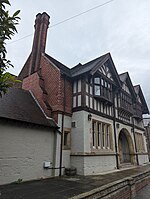York City Rowing Club
1843 establishments in EnglandRiver Ouse, YorkshireRowing clubs in EnglandSport in YorkSports clubs and teams established in 1843 ... and 1 more
Use British English from January 2021

York City Rowing Club is a rowing club by the River Ouse in York, England. It has over 200 members, of all ages. The boathouse is on the west (here briefly south) bank of the river next to Lendal Bridge and in Memorial Gardens. The club has modern buildings but is three years older than the oldest coastal rowing club in Britain, Dover; it is 25 years younger than the oldest non-academic rowing club, Leander. The reach of canalised river it enjoys is unusually long – over 20 mi (32 km).
Excerpt from the Wikipedia article York City Rowing Club (License: CC BY-SA 3.0, Authors, Images).York City Rowing Club
Leeman Road, York Bishophill
Geographical coordinates (GPS) Address Nearby Places Show on map
Geographical coordinates (GPS)
| Latitude | Longitude |
|---|---|
| N 53.9598 ° | E -1.0907 ° |
Address
Leeman Road
YO26 4ZP York, Bishophill
England, United Kingdom
Open on Google Maps











